NCERT Exemplar Solutions: Symmetry & Practical Geometry | Mathematics (Maths) Class 6 PDF Download
Exercise Page: 136
In questions 1 to 17, out of the given four options, only one is correct. Write the correct answer.
Q.1. In the following figures, the figure that is not symmetric with respect to any line is: (A) (i)
(A) (i)
(B) (ii)
(C) (iii)
(D) (iv)
Ans: b
A figure is said to have line symmetry, if by folding the figure along a line, the left and right parts of it coincide exactly. The line is called the line (or axis) of symmetry of the figure.
Q.2. The number of lines of symmetry in a scalene triangle is
(A) 0
(B) 1
(C) 2
(D) 3
Ans: a
A scalene triangle is a triangle that has three unequal sides.
Therefore, there is no lines of symmetry in a scalene triangle.
Q.3. The number of lines of symmetry in a circle is
(A) 0
(B) 2
(C) 4
(D) more than 4
Ans: d
Q.4. Which of the following letters does not have the vertical line of symmetry?
(A) M
(B) H
(C) E
(D) V
Ans: c

Q.5. Which of the following letters have both horizontal and vertical lines of symmetry?
(A) X
(B) E
(C) M
(D) K
Ans: a

Q.6. Which of the following letters does not have any line of symmetry?
(A) M
(B) S
(C) K
(D) H
Ans: b
Q.7. Which of the following letters has only one line of symmetry?
(A) H
(B) X
(C) Z
(D) T
Ans: d
Q.8. The instrument to measure an angle is a
(A) Ruler
(B) Protractor
(C) Divider
(D) Compasses
Ans: b
An instrument for measuring angles, typically in the form of a flat semicircle marked with degrees along the curved edge.
Q.9. The instrument to draw a circle is
(A) Ruler
(B) Protractor
(C) Divider
(D) Compasses
Ans: d
The instrument to draw a circle is compasses.
Q.10. Number of set squares in the geometry box is
(A) 0
(B) 1
(C) 2
(D) 3
Ans: c
Q.11. The number of lines of symmetry in a ruler is
(A) 0
(B) 1
(C) 2
(D) 4
Ans: c
We know that, ruler has shape of rectangle,
So, the number of lines of symmetry in a ruler is 2.
Q.12. The number of lines of symmetry in a divider is
(A) 0
(B) 1
(C) 2
(D) 3
Ans: b
The number of lines of symmetry in a divider is 1.
Q.13. The number of lines of symmetry in compasses is
(A) 0
(B) 1
(C) 2
(D) 3
Ans: a
Therefore, there is no lines of symmetry in a compasses.
Q.14. The number of lines of symmetry in a protractor is
(A) 0
(B) 1
(C) 2
(D) more than 2
Ans: b
Therefore, there is only one line of symmetry in a protractor.
Q.15. The number of lines of symmetry in a 45o – 45o – 90o set-square is
(A) 0
(B) 1
(C) 2
(D) 3
Ans: b
From the question it is given that, measurement of an isosceles triangle.
So, the number of lines of symmetry in given set-square is 1.
Q.16. The number of lines of symmetry in a 30o – 60o – 90o set square is
(A) 0
(B) 1
(C) 2
(D) 3
Ans: a
From the question it is given that, measurement of scalene triangle.
So, the number of lines of symmetry in given set-square is 0.
Q.17. The instrument in the geometry box having the shape of a triangle is called a
(A) Protractor
(B) Compasses
(C) Divider
(D) Set-square
Ans: d
In questions 18 to 42, fill in the blanks to make the statements true.
Q.18. The distance of the image of a point (or an object) from the line of symmetry (mirror) is ______ as that of the point (object) from the line (mirror).
Ans: The distance of the image of a point (or an object) from the line of symmetry (mirror) is same as that of the point (object) from the line (mirror).
Q.19. The number of lines of symmetry in a picture of Taj Mahal is ______ .
Ans: The number of lines of symmetry in a picture of Taj Mahal is one.
Q.20. The number of lines of symmetry in a rectangle and a rhombus are ______. (equal/unequal).
Ans: The number of lines of symmetry in a rectangle and a rhombus are equal.
Q.21. The number of lines of symmetry in a rectangle and a square are ______ (equal/unequal).
Ans: The number of lines of symmetry in a rectangle and a square are unequal.
Q.22. If a line segment of length 5cm is reflected in a line of symmetry (mirror), then its reflection (image) is a ______ of length ______.
Ans: If a line segment of length 5cm is reflected in a line of symmetry (mirror), then its reflection (image) is a line segment of length 5cm.
Q.23. If an angle of measure 80o is reflected in a line of symmetry, then the reflection is an ______ of measure ______.
Ans: If an angle of measure 80o is reflected in a line of symmetry, then the reflection is an angle of measure 80o.
Q.24. The image of a point lying on a line l with respect to the line of symmetry l lies on _______.
Ans: The image of a point lying on a line l with respect to the line of symmetry l lies on line l.
Q.25. In Fig. 9.10, if B is the image of the point A with respect to the line l and P is any point lying on l, then the lengths of line segments PA and PB are _______.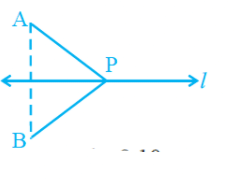 Ans: In Fig. 9.10, if B is the image of the point A with respect to the line l and P is any point lying on l, then the lengths of line segments PA and PB are equal.
Ans: In Fig. 9.10, if B is the image of the point A with respect to the line l and P is any point lying on l, then the lengths of line segments PA and PB are equal.
Q.26. The number of lines of symmetry in Fig. 9.11 is ______.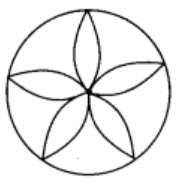 Ans: The number of lines of symmetry in Fig. 9.11 is 5.
Ans: The number of lines of symmetry in Fig. 9.11 is 5.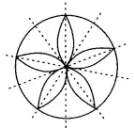
Q.27. The common properties in the two set-squares of a geometry box are that they have a ______ angle and they are of the shape of a ______.
Ans: The common properties in the two set-squares of a geometry box are that they have a right angle and they are of the shape of a triangle.
Q.28. The digits having only two lines of symmetry are ______ and ______.
Ans: The digits having only two lines of symmetry are 0 and 8.
Q.29. The digit having only one line of symmetry is ______.
Ans: The digit having only one line of symmetry is 3.
Q.30. The number of digits having no line of symmetry is ______.
Ans: The number of digits having no line of symmetry is 7.
The digits having no line of symmetry are 1, 2, 4, 5, 6, 7 and 9.
Q.31. The number of capital letters of the English alphabets having only vertical line of symmetry is ____.
Ans: 7
The letters are A, M, T, U, V, W and Y having only vertical line of symmetry.
Q.32. The number of capital letters of the English alphabets having only horizontal line of symmetry is ____.
Ans: 5
The letters are B, C, D, E and K having only horizontal line of symmetry.
Q.33. The number of capital letters of the English alphabets having both horizontal and vertical lines of symmetry is ___.
Ans: 4
The letters are H, I, O and X having both horizontal and vertical line of symmetry.
Q.34. The number of capital letters of the English alphabets having no line of symmetry is ___.
Ans: 10
The letters are F, G, J, L, N, P, Q, R, S and Z having no line of symmetry.
Q.35. The line of symmetry of a line segment is the ____ bisector of the line segment.
Ans: Perpendicular
Q.36. The number of lines of symmetry in a regular hexagon is ____.
Ans: 6
Q.37. The number of lines of symmetry in a regular polygon of n sides is ____.
Ans: n
Q.38. A protractor has ____ line/lines of symmetry.
Ans: 1
Q.39. A 30° – 60° – 90° set-square has ___ line/lines of symmetry.
Ans: No
Q.40. A 45° – 45° – 90° set-square has ___ line/lines of symmetry.
Ans: One
Q.41. A rhombus is symmetrical about ____.
Ans: Diagonals
Q.42. A rectangle is symmetrical about the lines joining the ___ of the opposite sides.
Ans: Mid points
Directions : In questions 43 to 61, state whether the statements are true (T) or false (F).
Q.43. A right triangle can have at most one line of symmetry.
Ans: True
A right triangle can have at most one line of symmetry if its remaining two angles are equal.
Q.44. A kite has two lines of symmetry.
Ans: False
Because a kite has only one line of symmetry.
Q.45. A parallelogram has no line of symmetry.
Ans: True
Q.46. If an isosceles triangle has more than one line of symmetry, then it need not be an equilateral triangle.
Ans: False
Since, isosceles triangle is symmetrical about the bisector of the angle included between the equal sides, i.e., only one line of symmetry.
∴ If it has more than one line of symmetry then it must be an equilateral triangle.
Q.47. If a rectangle has more than two lines of symmetry, then it must be a square.
Ans: True
Q.48. With ruler and compasses, we can bisect any given line segment.
Ans: True
Q.49. Only one perpendicular bisector can be drawn to a given line segment.
Ans: True
Q.50. Two perpendiculars can be drawn to a given line from a point not lying on it.
Ans: False
Since, only one perpendicular can be drawn to a given line from a point not lying on it.
Q.51. With a given centre and a given radius, only one circle can be drawn.
Ans: True
Q.52. Using only the two set-squares of the geometry box, an angle of 40° can be drawn.
Ans: False
Q.53. Using only the two set-squares of the geometry box, an angle of 15° can be drawn.
Ans: True
Using 45° – 45° – 90° set square we can draw an angle of 45°. Now using 30° – 60° – 90° set square we can draw an angle of 30° inside the 45° angle taking one arm common in both. So, the angle between 45° and 30° is 15°.
Q.54. If an isosceles triangle has more than one line of symmetry, then it must be an equilateral triangle.
Ans: True
Q.55. A square and a rectangle have the same number of lines of symmetry.
Ans: False
A square has 4 lines of symmetry whereas rectangle has 2 lines of symmetry.
Q.56. A circle has only 16 lines of symmetry.
Ans: False
Since, a circle is symmetrical about each of its diameters. So it has infinite lines of symmetry.
Q.57. A 45° – 45° – 90° set-square and a protractor have the same number of lines of symmetry.
Ans: True
Since, both 45° – 45° – 90° set-square and protractor have only one line of symmetry.
Q.58. It is possible to draw two bisectors of a given angle.
Ans: False
Since, we can draw only one bisector of a given angle.
Q.59. A regular octagon has 10 lines of symmetry.
Ans: False
Since, a regular octagon has 8 sides.
∴ It must have 8 lines of symmetry.
Q.60. Infinitely many perpendiculars can be drawn to a given ray.
Ans: True .
Q.61. Infinitely many perpendicular bisectors can be drawn to a given ray.
Ans: False
Q.62. Is there any line of symmetry in the given figure? If yes, draw all the lines of symmetry.
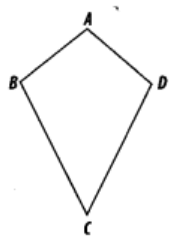
Ans: Yes, the given figure has one line of symmetry.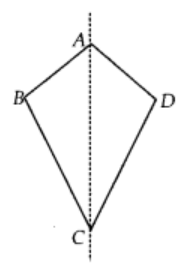
Q.63. In the given figure PQRS is a rectangle. State the lines of symmetry of the rectangle.
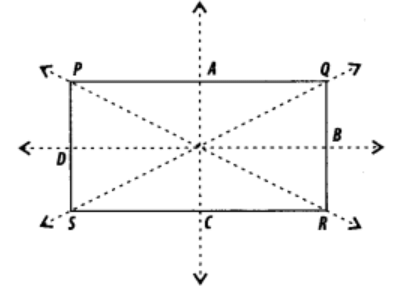
Ans:
As we know that a rectangle has two lines of symmetry, which are obtained by joining the midpoints of opposite sides.
∴ The given figure shows that AC and BD are the lines of symmetry.
Q.64. Write all the capital letters of the English alphabets which have more than one lines of symmetry.
Ans: The capital letters of English alphabets which have more than one lines of symmetry are as follows:

Q.65. Write the letters of the word ‘MATHEMATICS’ which have no line of symmetry.
Ans: The letter S of the given word have no line of symmetry.
Q.66. Write the number of lines of symmetry in each letter of the word ‘SYMMETRY’.
Ans: S and R has no line of symmetry whereas all the remaining letters has only one line of symmetry.

Q.67. Match the following.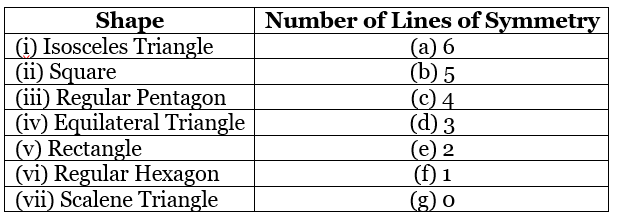 Ans:
Ans: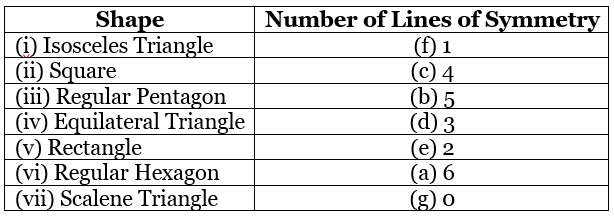
Q.68. Open your geometry box. There are some drawing tools. Observe them and complete the following table:

Ans:
(i) The ruler has 2 lines of symmetry.
(ii) The divider has 1 line of symmetry.
(iii) The compasses has no line of symmetry.
(iv) The protactor has 1 line of symmetry.
(v) Triangular piece with two equal sides has 1 line of symmetry.
(vi) Triangular piece with unequal sides has no line of symmetry.
Q.69. Draw the images of points A and B in line l of the given figure and name them as A’ and B’ respectively. Measure AB and A’B’. Are they equal?
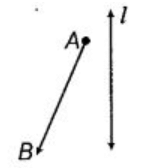
Ans:
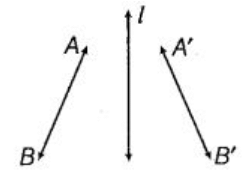
Yes, the measurement of AB and A’B’ will be equal.
Q.70. In the given figure, the point C is the image of point A in line l and line segment BC intersects the line l at P.
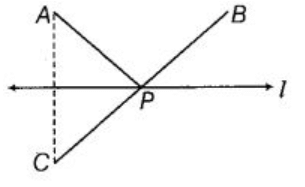
(a) Is the image of P in line l the point P itself?
(b) Is PA = PO
(c) Is PA + PB = PC + PB?
(d) Is P that point on line l from which the sum of the distances of points A and B is minimum?
Ans: (a) Yes (b) Yes (c) Yes
Since, PA = PC
⇒ PA + PB = PC + PB
[By adding PB on both sides]
(d) Yes, since, PA + PB = CP + PB
Now, CP + PB will be minimum when C, P and B lie on a line.
Q.71. Complete the figure so that line l becomes the line of symmetry of the whole figure.
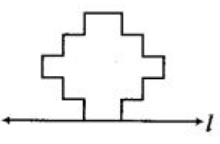
Ans:
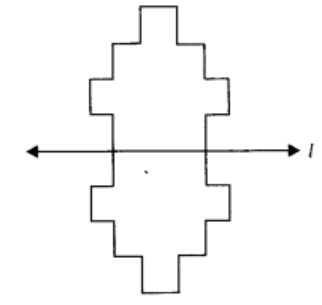
Q.72. Draw the images of the points A, B and C in the line m (see figure). Name them as A’, B’ and C’, respectively and join them in pairs. Measure AB, BC, CA, A’B’, B’C’ and CA’. Is AB = A’B’, BC = B’C’ and CA = C’A’?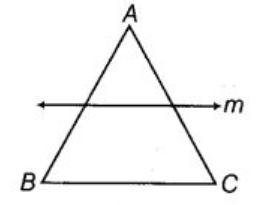
Ans:
Yes, AB = A’B’, BC = B’C’ and CA = CA’
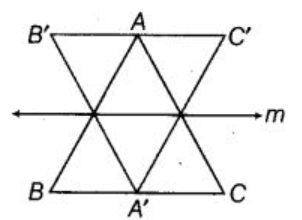
Q.73. Draw the images P’, Q’ and R’ of the points P, Q and R, respectively in the line n (see figure). Join P’Q’ and Q’R’ to form an angle P’Q’R’. Measure ∠PQR and ∠P’Q’R’. Are the two angles equal?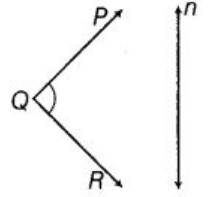
Ans:
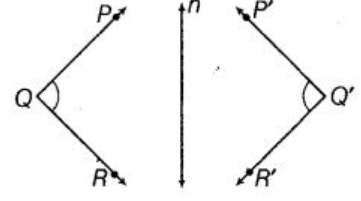
Yes, ∠PQR and ∠P’Q’R’
Q.74. Complete the figure by taking l as the line of symmetry of the whole figure.
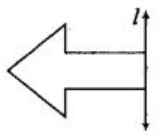
Ans:
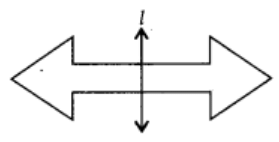
Q.75. Draw a line segment of length 7 cm. Draw its perpendicular bisector, using ruler and compasses.
Ans: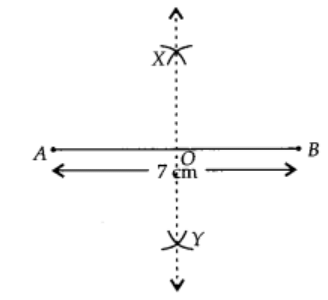
Steps of construction:
(i) Draw a line segment AB = 7 cm.
(ii) With A as centre and radius more than half of AB, draw arcs, one on each side of AB.
(iii) With B as centre and same radius as before, draw arcs, cutting the previously drawn arcs at X and Y respectively.
(iv) Now join XY, meeting AB at O.
Thus, XY is the perpendicular bisector of AB.
Q.76. Draw a line segment of length 6.5 cm and divide it into four equal parts, using ruler and compasses.
Ans:
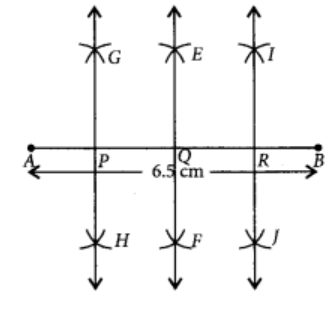
Steps of construction:
(i) Draw a line segment AB = 6.5 cm.
(ii) With A and B as centres and radius more than  draw arcs one on each side of AB, these arcs cuts each other at E and F.
draw arcs one on each side of AB, these arcs cuts each other at E and F.
(iii) Join EF, which cuts AB at Q.
(iv) With centres A and Q and radius more than draw arcs one on each side of AB, these arcs cuts each other at G and H.
draw arcs one on each side of AB, these arcs cuts each other at G and H.
(v) Join GH, which cuts AB at P.
(vi) Similarly, with centres B and Q and radius more than draw arcs one on each side of AB, these arcs cuts each other at I and J.
draw arcs one on each side of AB, these arcs cuts each other at I and J.
(vii) Join IJ, which cuts AB at R.
(viii) Now, point P, Q and R divide the line segment AB in four equal parts.
Thus AP = PQ = QR = RB.
Q.77. Draw an angle of 140° with the help of a protractor and bisect it using ruler and compasses.
Ans:
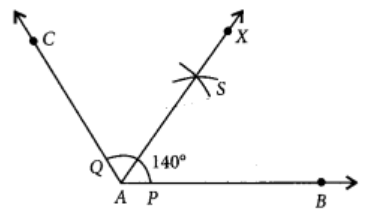
Steps of construction:
(i) Draw ∠BAC = 140° with the help of protractor.
(ii) With A as centre and any convenient radius, draw an arc, cutting AC and AB at Q and P respectively.
(iii) With centre P and radius more than  draw an arc.
draw an arc.
(iv) With centre Q and the same radius as before, draw another arc, cutting the previously drawn arc at a point S.
(v) Join AS and produce it to any point X. Then, ray AX bisects ∠CAB.
Q.78. Draw an angle of 65° and draw an angle equal to this angle, using ruler and compasses.
Ans:
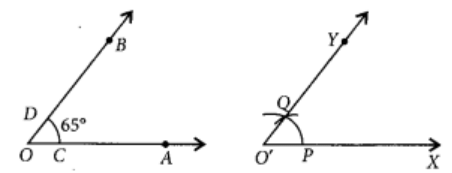
Steps of construction:
(i) Draw ∠AOB = 65° with the help of protractor.
(ii) Draw a ray O’X.
(iii) With O as centre and any radius, draw an arc cutting OA and OB at C and D respectively.
(iv) With O’ as centre and with the same radius, draw an arc, cutting O’X at P.
(v) With P as centre and radius equal to CD, cut the arc through P at Q.
(vi) Join O’Q and produce it to Y.
Then ∠YO’X is the required angle equal to ∠AOB.
Q.79. Draw an angle of 80° using a protractor and divide it into four equal parts, using ruler and compasses. Check your construction by measurement.
Ans:
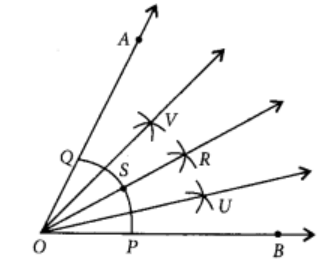
Steps of construction:
(i) Draw ∠AOB = 80° with the help of protractor.
(ii) With centre O and any radius, draw an arc, meeting  and
and
at P and Q respectively.
(iii) With centres P and Q and radius more than  draw arcs which cuts each other at R.
draw arcs which cuts each other at R.
(iv) Join OR which bisects PQ at S.
(v) With centres P and S and radius more than draw arcs which cuts each other at U.
draw arcs which cuts each other at U.
(vi) Join OU.
(vii) With centres Q and S and radius more than draw arcs which cuts each other at U.
draw arcs which cuts each other at U.
(vi) Join OU.
(vii) With centres Q and S and radius more than  draw arcs which cuts each other at V
draw arcs which cuts each other at V
(viii) Join OV. Thus, ∠AOV, ∠VOR, ∠ROU and ∠UOB divide ∠BOA in four equal parts and ∠AOV = ∠VOR = ∠ROU = 20°
Q.80. Draw a circle of radius 6 cm using ruler and compasses. Draw one of its diameters. Draw the perpendicular bisector of this diameter. Does this perpendicular bisector contain another diameter of the circle?
Ans:

Steps of construction:
(i) Draw a circle with centre O of radius 6 cm.
(ii) Now, draw a diameter AB of the circle.
(iii) With the centre B and the radius more than draw the arcs on each side of AB.
draw the arcs on each side of AB.
(iv) With the centre A and the same radius, draw the arcs on each side of AB which cuts the previously drawn arc at X and Y.
(v) Now join OX and OY and produce them to any points P and Q.
Thus PQ bisects the diameter of a circle. Yes, the perpendicular PQ contains another diameter of this circle.
Q.81. Bisect ∠XYZ of figure.
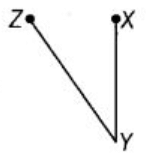
Ans:
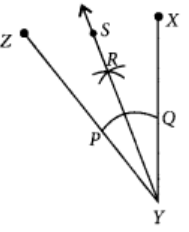
Steps of construction:
(i) With centre Y and any radius draw an arc which cuts ZY at P and XY at Q.
(ii) With centre Q and radius more than  draw an arc.
draw an arc.
(iii) With centre P and same radius draw an arc which cuts the previously drawn arc at R.
(iv) Join YR and produce it to any point S. Thus is the bisector of ∠XYZ.
is the bisector of ∠XYZ.
Q.82. Draw at angle of 60° using ruler and compasses and divide it into four equal parts. Measure each part.
Ans:
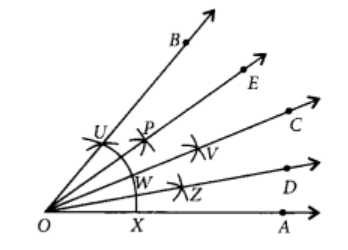
Steps of construction:
(i) Draw a ray (ii) With O as centre and any convenient radius draw an arc meeting the rav OA at X.
(ii) With O as centre and any convenient radius draw an arc meeting the rav OA at X.
(iii) With X as centre and the same radius draw an arc which cuts the previously drawn arc at U.
(iv) Join OU and produce it to any point B. So ∠BOA = 60°.
(v) Now with centre X and U and radius more than  draw the arcs on the same side of ∠BOA which cuts each other at V.
draw the arcs on the same side of ∠BOA which cuts each other at V.
(vi) Join OV and produce it any point C as well as it cuts the arc at W.
at W.
(vii) Again with the centre X and W and radius more than 
draw the arcs on the same side of ∠BOA which cuts each other at Z.
(viii) Join OZ and produce it to any point D.
(ix) With the centre U and W and radius more than draw the arcs on the same side of ∠BOA with cuts each other at the point P.
draw the arcs on the same side of ∠BOA with cuts each other at the point P.
(x) Join OP and produce it to any point E. Now with the help of protractor we observe that each angle i.e, ∠BOE = ∠EOC = ∠COD = ∠DOA = 15°.
Q.83. Bisect a straight angle, using ruler and compasses. Measure each part.
Ans:
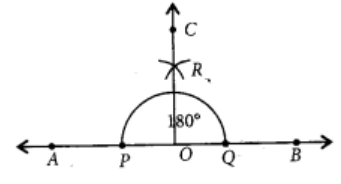
Steps of construction:
(i) Draw a line AB of any length.
(ii) Draw an arc of 180° which meets the ray  at P and ray
at P and ray at Q.
at Q.
(iii) Taking P and Q as centres and radius more than draw two arcs which intersect each other at R.
draw two arcs which intersect each other at R.
(iv) Join OR and produce it to any point C.
(v) Thus,
bisect the straight angle. Now, on measuring each angle we get, ∠BOC = ∠AOC = 90°.
Q.84. Bisect a right angle, using ruler and compasses. Measure each part. Bisect each of these parts. What will be the measure of each of these parts?
Ans:
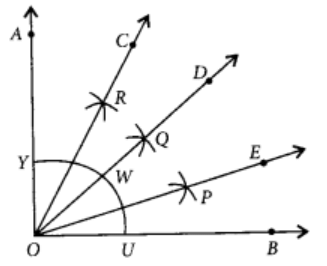
Steps of construction:
(i) Draw ∠AOB = 90° with the help of protractor.
(ii) Draw an arc with centre O and any radius, which cuts the ray OB and OA at U and Y.
(iii) With centres U and Y draw the arcs with radius more than 
which cuts each other at Q.
(iv) Join OQ and produce it to any point D as well as it cuts the arc 
at W
(v) With centres U and W and radius more than 
raw the arcs which cuts each other at P.
(vi) Join OP and produce it to any point E.
(vii) Now with centres Y and W and radius more than 
draw the arcs which cuts each other at R.
(viii) Join OR and produce it to any point C. On measuring, we have ∠BOD = ∠AOD = 45° and ∠BOE = ∠EOD = ∠DOC = ∠COA = 
Q.85. Draw an angle ABC of measure 45°, using ruler and compasses. Now draw an angle DBA of measure 30°, using ruler and compasses as shown in figure. What is the measure of ∠DBC ?
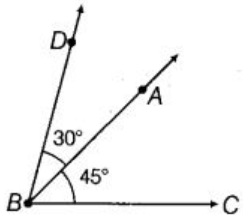
Ans:
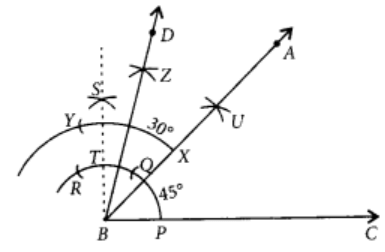
Steps of construction:
(i) Draw a ray 
(ii) With B as centre and any radius draw an arc which cuts BC at P.
(iii) With centre P and same radius, draw an arc which cuts the previously drawn arc at Q.
(iv) Similarly, with Q as centre and same radius draw an another arc which cuts the previously drawn arc at R.
(v) With centre R and Q and same radius draw the arcs which cuts each other at S.
(vi) Join BS which cuts the arc RP at T.
(vii) With centre P and T and radius more than 
draw the arcs which cuts each other at U.
(viii) Join BU and produce it to a point A. Thus ∠ABC = 45°.
(ix) Now, with B as centre draw another arc which cuts the line AB at X.
(x) With centre X and same radius draw an arc which cut the arc drawn in step (ix) at Y.
(xi) With centre X and Y and radius more than

draw two arcs which cuts each other at Z.
(xii) Join BZ and produced it to a point D. Thus ∠ABD = 30°.
On measuring, we get ∠DBC = 75°
Q.86. Draw a line segment of length 6 cm. Construct its perpendicular bisector. Measure the two parts of the line segment.
Ans:
Steps of construction:
(i) Draw a line segment AB = 6 cm
(ii) With centre A and radius more than draw the arcs on each side of AB.
draw the arcs on each side of AB.
(iii) With centre B and same radius draw the arcs on each side of AB, which cuts the previously drawn arcs at X and Y.
(iv) Join XY which cuts the line segment AB at O.
Thus XY is the perpendicular bisector of AB.
On measuring the two parts, we get AO = OB = 3 cm.
Q.87. Draw a line segment of length 10 cm. Divide it into four equal parts. Measure each of these parts.
Ans:
Steps of construction:
(i) Draw a line segment AB = 10 cm.
(ii) With A and B as centres and radius more than 
draw arcs on each side
AB, these arcs cuts each other at R at S.
(iii) Join RS, which cuts AB at a point O.
(iv) Now, with centres A and O and radius more than  draw arcs on each side of AB, these arcs cuts each other at P and Q.
draw arcs on each side of AB, these arcs cuts each other at P and Q.
(v) Join PQ, which cuts AB at M.
(vi) Similarly, with centres B and O and radius more than
draw arcs on each side of AB, these arcs cuts each other at T and U.
(vii) Join TU, which cuts AB at N. Thus the measurement of each i.e., AM, MO, ON and NB is equal to 2.5 cm.
|
92 videos|353 docs|54 tests
|
FAQs on NCERT Exemplar Solutions: Symmetry & Practical Geometry - Mathematics (Maths) Class 6
| 1. What is symmetry in practical geometry? |  |
| 2. How do you identify symmetry in a geometric figure? |  |
| 3. Can all geometric figures have symmetry? |  |
| 4. What is the importance of symmetry in practical geometry? |  |
| 5. How can symmetry be used practically in everyday life? |  |





















